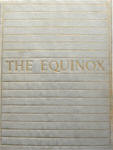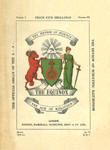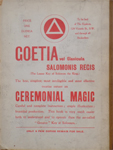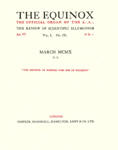100th
MP

|
THE
100th
MONKEY
PRESS |
|
|
|
Limited Editions by Aleister Crowley & Victor B. Neuburg |
|
Bibliographies |
|
Download Texts
»
Aleister
Crowley
WANTED !!NEW!!
|
|
THE EQUINOX VOLUME I, NUMBER III |
|
Image Thumbnails |
||||||||||||||||||||||||||||||||||||||||||||||||||||||||||
|
Title: |
The Equinox (Volume I, Number III). The Official Organ of the A\A\ |
|
||||||||||||||||||||||||||||||||||||||||||||||||||||||||
|
Variations: |
|
|||||||||||||||||||||||||||||||||||||||||||||||||||||||||
|
Publisher: |
Simpkin, Marshall, Hamilton, Kent and Co.1 |
|||||||||||||||||||||||||||||||||||||||||||||||||||||||||
|
Printer: |
Ballantyne & Company, Limited.2 |
|||||||||||||||||||||||||||||||||||||||||||||||||||||||||
|
Published At: |
London.1 |
|||||||||||||||||||||||||||||||||||||||||||||||||||||||||
|
Date: |
March 1910.2 |
|||||||||||||||||||||||||||||||||||||||||||||||||||||||||
|
Edition: |
1st Edition. |
|||||||||||||||||||||||||||||||||||||||||||||||||||||||||
|
Pages: |
xviii + 332 + 76 (Supplement) + vii advertisements.2 |
|||||||||||||||||||||||||||||||||||||||||||||||||||||||||
|
Price: |
Priced at 1 guinea6 for the subscriber‘s edition and 5 shillings2 for the regular edition. |
|||||||||||||||||||||||||||||||||||||||||||||||||||||||||
|
Remarks: |
The title page is printed in black and red.2 This volume had already been printed and was at the binders when Crowley received word that MacGregor Mathers had obtained an injunction to prevent publication. The fifty Deluxe buckram copies had already been bound and so went out to subscribers. The remaining ordinary copies were held until the outcome of the court case was settled. Once the verdict was rendered in Crowley's favor he had the original editorial page removed from the ordinary copies and replaced with a 'cancel' giving details of the court case.7 The editorial contained in the “deluxe edition” subscription copies is different from the editorial contained in the “standard” edition. The editorial originally read, at the bottom of page 1, “Mr. H. Sheridan-Bickers will lecture on behalf of The Equinox during the year. We shall be glad if our readers will arrange with him through us to speak in their towns. Mr. Bickers makes no charge for lecturing, and The Equinox may assist if desired in meeting the necessary expenses.” This original editorial was excised and a modified editorial was tipped into the “standard” edition that, at the bottom of page 1, now read “Two days after the bound advance copies of this Number were delivered by the printer, an order was made restraining publication, continued by Mr. Justice Bucknill, and dissolved by the Court of Appeal.” 2 Some of the “deluxe edition” subscription copies have a color frontispiece of the Equinox “coat of arms” design which is not present in the standard editions.4 |
|||||||||||||||||||||||||||||||||||||||||||||||||||||||||
|
Pagination:2 |
|
|||||||||||||||||||||||||||||||||||||||||||||||||||||||||
|
Contents: |
|
|||||||||||||||||||||||||||||||||||||||||||||||||||||||||
|
Author’s Working Versions: |
|
|||||||||||||||||||||||||||||||||||||||||||||||||||||||||
|
Other Known Editions: |
||||||||||||||||||||||||||||||||||||||||||||||||||||||||||
|
Bibliographic Sources: |
|
|||||||||||||||||||||||||||||||||||||||||||||||||||||||||
|
Comments by Aleister Crowley: |
“The Equinox” should have been, on its merits, a very successful venture. Frank Harris had generously given me one of the best stories he ever wrote, “The Magic Glasses”. Fuller had contributed a gargantuan preface to The Temple of Solomon the King (the title of the story of my magical career), a series of sublimely eloquent rhapsodies descriptive of the various possible attitudes towards existence. There were three important instructions in Magick; the best poem of its kind that I had so far written, “The Wizard Way”; “At the Fork of the Roads”, a true and fascinating story of one of my early magical experiences; The Soldier and the Hunchback ! and ? which I still think one of the subtlest analyses that has ever been written on ontology, with its conclusion: that ecstatic affirmation and sceptical negation are neither of them valid in themselves but are alternate terms in an infinite series, a progression which is in itself a sublime and delightful path to pursue. Disappointment arises from the fear that every joy is transient. If we accept it as such and delight to destroy our own ideals in the faith that the very act of destruction will encourage us to rebuild a nobler and loftier temple from the debris of the old, each phase of our progress will be increasingly pleasant. “pi alpha mu phi alpha gamma epsilon pi alpha gamma gamma epsilon nu epsilon tau omega rho”, “All devouerer, all begetter”, is the praise of Pan. — The Confessions of Aleister Crowley. New York, NY. Hill and Wang, 1969. Page 603. ______________________________
The supplement to the first number of The Equinox is a plain reprint of my Magical Record in Paris, mentioned above. I have omitted no detail of my doings. My dinners, my dalliance and my other diversions are described as minutely as my Magick, my mantras and my meditations. Nothing of the sort had ever been published before. It is a complete demonstration of the possibility of achieving the most colossal results in conditions which had hitherto been considered an absolute bar to carrying on even elementary work. It proves my proposition that the efficacy of traditional practices is independent of dogmatic and ethical considerations; and, moreover, that my sceptical formulae based on a purely agnostic viewpoint, and on the facts of physiology and psychology, as understood by modern materialists, were entirely efficacious. In summary, let me add that The Equinox was the first serious attempt to put before the public the facts of occult science, so-called, since Blavatsky’s unscholarly hotch-poch of fact and fable, Isis Unveiled. It was the first attempt in history to treat the subject with scholarship and from the standpoint of science. No previous book of its kind can compare with it for the perfection of its poetry and prose; the dignity and sublimity of its style, and the rigidity of its rule never to make any statement which could not be proved as precisely as the mathematician exacts. I confess to being entirely proud of having inaugurated an epoch. From the moment of its appearance, it imposed its standards of sincerity, scholarship, scientific seriousness and aristocracy of all kinds, from the excellence of its English to the perfection of its printing, upon everyone with ambition to enter this field of literature.
It did not command a large public, but
its influence has been enormous. It is recognized as the
standard publication of its kind, as encyclopedia without
“equal, son, or companion”. It has been quoted, copied and
imitated everywhere. Innumerable cults have been founded by
charlatans on its information. Its influence has changed the
whole current of thought of students all over the world. Its
inveterate enemies are not only unable to ignore it, but submit
themselves to its sovereignty. It was thus entirely successful
from my personal point of view. I had put a pearl of great price
in a shop window, whose other exhibits were pasted diamonds and
bits of coloured glass for the most part, and at best, precious
stones of the cheaper and commoner kind. From the moment of its
appearance, everyone had to admit — for the most part with
hatred and envy in their hearts — that the sun had appeared in
the slum and put to shame the dips and kerosene lamps which had
lighted it till then. It was no longer possible to carry on
hole-in-the-corner charlatanism as heretofore. — The Confessions of Aleister Crowley. New York, NY. Hill and Wang, 1969. Pages 604-605. ______________________________
To return to The Equinox, there was no question of selling even that small edition even at that pitiful price. I have never had any idea of how to do business. I can make plans, both sound and brilliant; but I cannot force myself to take the necessary steps to put them into practice. My greatest weakness is that as soon as I am sure that I can attain any given object, from climbing a mountain to exploiting a beauty spot, I lose interest. The only things I complete are those of which (as for instance, poetry and Magick) I am not the real author but an instrument impelled by a mysterious power which sweeps me away in effortless enthusiasm which leaves no room for my laziness, cynicism and similar inhibiting qualities to interfere. I did try to get a few booksellers to stock The Equinox but found myself immediately up against a blank wall of what I must call Chinese conventionality. I remember hearing of an engineer in the East who wanted to built himself a house and employed a Chinese contractor. He pointed out that the work would be much easier by using bricks of a different size to that which the man was making. He obeyed, but a day later went back to the old kind. The engineer protested, but the man explained that his bricks were of a “heaven-sent” size. So I found that the format of The Equinox shocked the bookseller; worse still, it was not a book, being issued periodically, nor a magazine, being to big and well produced! I said, “What does it matter? All I ask you to do is to show it and sell it.” Quite useless. — The Confessions of Aleister Crowley. New York, NY. Hill and Wang, 1969. Pages 605-606. |
|||||||||||||||||||||||||||||||||||||||||||||||||||||||||
|
Reviews: |
From Mssrs Simpkin, Marshall, & Co., London, comes the third number (5s.), dated March 1910, of that mystical and esoteric publication, The Equinox, the nature of which, as a review of “Scientific Illuminism” and the official organ of the A.A., has already been remarked upon in these columns when its earlier numbers came out. This number opens with a wholly occult “Liber XIIL,” or “syllabus of steps upon the path,” explaining (if that word can be properly used here) the functions of various officers in some mysterious ritual. There is an impossible poem by Allister Crowley, entitled “Aha!” and a continuation of a translation by the same writer of a poem by Baudelaire. Mr George Raffalovich contributes a story; there is a continuation of the description of “The Temple of Solomon the King,” and the number, as a whole, has every appearance of being likely to satisfy readers who must occupy themselves, seriously or not, with Rosicrucianism, Buddhism, Hashish-visions, and, in short, whatsoever is ultimately incomprehensible. —The Scotsman, 4 April 1910. ______________________________
The new number of “The Equinox” continues to keep up the tradition of the earlier numbers as to size, the mystical nature of its contents, and the unintelligibility of many of its articles. . . . —Review of Reviews, date unknown. ______________________________
Here is the weirdest muddle that one could well stumble across in this most muddled age. . . . Powerfully individualistic, descending sometimes nearly to the level of the sordid, soaring sometimes to the heights of genius, the matter could not be reviewed properly in twenty times the space that we can give it. . . . Those who are certain of their sanity and the breadth of their viewpoint should read this magazine when they get the opportunity. Theosophists will find the few references to Theosophy anything but complimentary. . . . —Theosophy in Scotland, date unknown. ______________________________
The Equinox is permanent in its stately size and type, continuous in its periodical character, permanent—in the value of its contents. —Vanity Fair, date unknown. ______________________________
Expensively printed lunacy, astrology, etc., in oriental-occidental jargon. —The Literary Guide, date unknown. ______________________________
It easily takes rank as the most vigorous swearer and blasphemous in respectable modern literature. Moreover its swearing and blasphemy are splendidly done, with immense style and glorious colouring. Its contributors certainly know how to write, though occasionally they remind one of certain efforts that have emanated from lunatic asylums where gorgeousness of imagination and riotous language are by no means unknown. But underneath all, there is a huge wealth of knowledge, a few indications of serious feeling, and a big flow of occult thought. Yet with all its “illuminism” it is so much of a mocker that we have before us the figure of a Mephistopheles. . . . The Equinox is put forth with a certain pomp, its writers are by no means negligible in competence. All we can say is that they remind us of Diakkas and Jingles, and occasionally of Colney Hatch. . . . The reference to black mass and the chaotic mixture may possibly help to explain the rumours of devil worship which were persistent not long ago. Perhaps we have here the key to that dark door. . . . —The Light, date unknown. ______________________________
A
mysterious publication called “The Equinox,” the official organ
of the A\
A\
has just been released upon a long-suffering world. . . . It is
a sort of thing no fellow can understand. One gathers
vaguely out of the confusion that it deals with such things as
Magic, wizardry, mysticism, and so on; but what the special line
is, remains a baffling mystery. . . . From frequent references
to some people called The Brothers of the A\
A\
one gathers that they have a lot to do with this weird venture;
but a grim perusal of an article purporting to explain the Order
. . . leaves one without any real clue as to their identity.
True, the Chief of the Brothers is definitely names, his name
being “V.V.V.V.V.” but five V’s, do not strike one as a name
likely to be well known at any local post office. . . . One gets
all kinds of entertainments in “The Equinox” . . . Poetry gets a
strong show, but it is uncomfortable reading. . . . |
|||||||||||||||||||||||||||||||||||||||||||||||||||||||||




